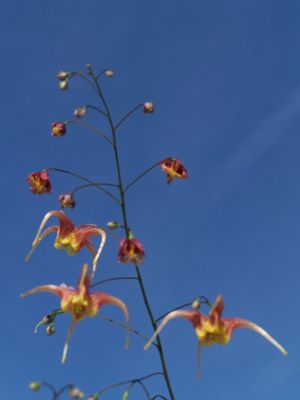Printed at http://www.quackingrassnursery.com/index.cfm/
Epimedium x 'Rigoletto'
Barrenwort
Plant Type:
SHADE PERENNIALSEpimedium x 'Rigoletto' - The four spurs on each of the numerous flowers are a deep dark red-purple with contrasting daffodil yellow-edged cup supported on wiry stems growing to one foot. Like aerialists, the little spiders dangle and dance in spring breezes above a safety net of dark green leaves. Clumping. Named by the folks at Fairweather Gardens for the protagonist in Verdi's opera, Rigoletto. Established pot grown plant from division.
Characteristics and Attributes for Epimedium x 'Rigoletto'
Season of Interest (Flowering)
- Spring
Season of Interest (Foliage)
- Spring / Summer / into Autumn
Nature Attraction
- Deer Resistant
Light
- Morning Sun / Afternoon Shade
- Shade
- Dappled Shade
Attributes
- Border
- Drought Tolerant
- Woodland
- Rock Garden
- Ground Cover
Growth Rate in the Garden
- Slow
Soil
- Fertile
- Woodland
- Draining
Origins
- Garden Origin
Propagated By
- Division
Genus Overview: Epimedium
The Barrenworts have received much attention in recent years and deservedly so. They come in many differently-colored flowering forms sporting delicate, dangling spider-like blossoms in spring. Some, as in E. sempervirens, are virtually evergreen; many others deciduous with delicate kidney-shaped leaves on wiry stems. The foliage on many cultivars in our USDA zone 5b (-15F) remains handsome until the winter solstice supplying 2 to 3 seasons of interest, some even provide golden to purple-bronze autumn tones. Slowly, gradually, they form a ground cover in part to full, open shade in fertile soil. The Barrenworts or Bishop Hats exhibit fair drought tolerance and are well-behaved members in part to open shade. They work well in herbaceous borders, woodland gardens or down-facing shrubs. Epimediums are members of the Berberidaceae and are of Asian origin. Once established they exhibit fair tolerance to dry shade. All of the following are pot-grown divisions from our plants.



